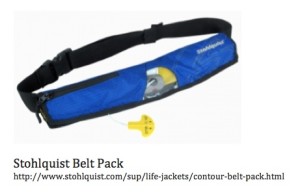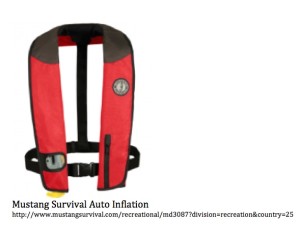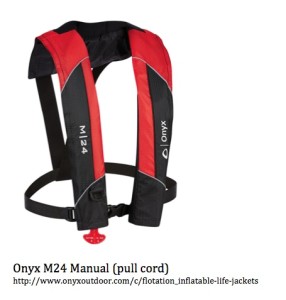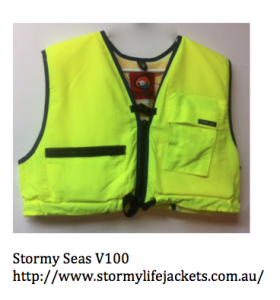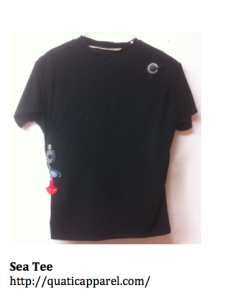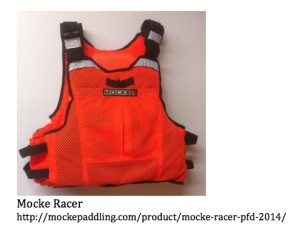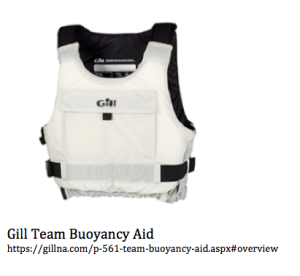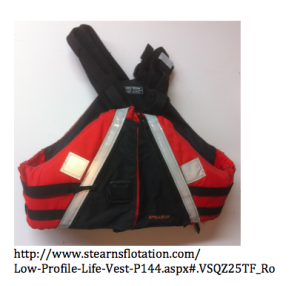“There are a lot of options for PFDs — some of which are compatible for wearing while rowing” USRowing Safety Feature, July, 2013
What’s the best PFD for rowers? THE ONE YOU WEAR! As former national team coach Gordon Hamilton has written, “Cold water is frightening… Find a PFD which will allow you to row comfortably. There are any number of these available.”
Over the past ten years an increasing number of PFDs have become available to rowers — and an increasing number of rowers have drowned without them. The belief that rowers shouldn’t wear lifejackets is a dangerous shibboleth. There are plenty of options for young rowers and for rowing on cold water or under dangerous conditions.
New since 2022 are the inflatable Wingman PFD from Hyde and the Alto Belt Pack from Spinlock. The ultra-slim profile of the Wingman with the pull cord tucked up below the left shoulder looks like a promising PFD for rowers. The Spinlock Belt Pack is also very slim, comfortable, and once inflated fits around the torso and under the arms (rather than over the head) for greater ease of use.


Cold water, USRowing warns us, is extremely dangerous and “below 50 degrees… the survival time is probably not long enough for a rescue.”* In reality, this means survival may depend on wearing a PFD and having a safety launch close by.


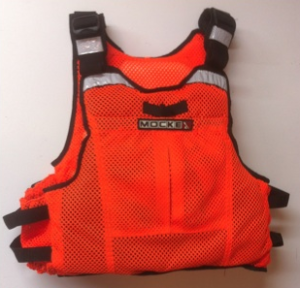
USRowing says there are PFDs compatible for rowing, so why not wear one when conditions are dangerous? There are a variety of different types including inflatable belt packs and suspender-types; inflatable buoyancy vests and shirts, European style PFDs, and USCG approved foam PFDs and an increasing number of clubs are now recommending them for cold water safety. Pictured above from left to right are the Mustang Khimera hybrid, the Float-tech Sea-Tee, and the Mocke Racer.
Listed below are examples of the variety of PFDs you may find compatible with your rowing style. [More information is available here on the dangers of cold water and comments from rowers who wear PFDs.]
2022: PFD updates and modifications
PFD manufacturers continue to update existing PFDs and introduce new ones, an increasing number of which appear suitable for rowing either in shells or open water boats.
In particular, Onyx has a line of life-vests designed for paddlers that was introduced in 2015 and seems to have the basic requirements for a rowing PFD: they’re low-profile with no straps, buckles or pockets in the from that might interfere with rowing. All are USCG rated Type III PFD with retail prices from about $50 to $90.
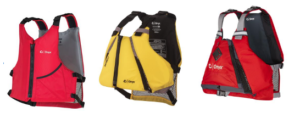
Dawid Mocka has updated his Racer PFD designed primarily for open water kayaking, surf-ski, and flat-water marathons, to make it both cooler (important to rowers) and more buoyant (less important to flatwater rowers).
Zhik has also introduced a new PFD that looks attractive for rowing. The P3 PFD has a flat front with only a fold over pocket, side entry, and what appears to be a relatively low front profile. The Zhik P3 (pictured below, left) and Mocke Racer (below, right) are both Australian PFDs and carry ISO Certifications.
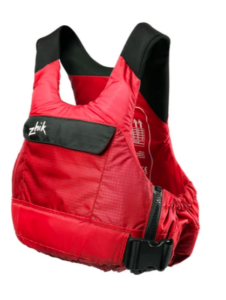

NEW FOR 2021: More low profile foam PFDs coming on the market
As new lifejackets and PFDs continue to come on the market it’s impossible for us to keep track of them, but here are several that have caught our eye:
Three flat front, slim profile, foam life jackets from NRS:
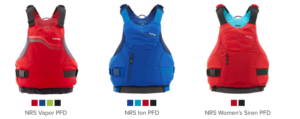
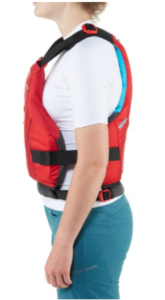 And another new jacket from Astral Designs:
And another new jacket from Astral Designs:
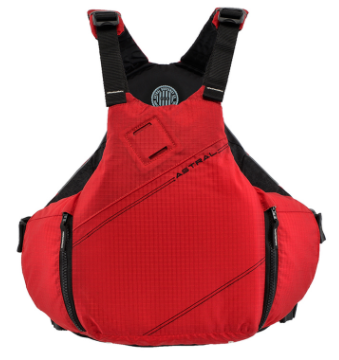
We haven’t tested any of these new models, but all of them appear to meet the primary criteria for suitable rowing PFDs: a slim profile and no buckles or straps that might catch on the stroke.
NEW for 2019: the New Wave Vest & Mustang Survival Khimera Hybrid
The new Mustang Khimera PFD (below, left) looks like it was designed for rowers. It’s slim, lightweight, comfortable, has no zippers, buckles, or straps on the front, and offers unrestricted motion for a smooth, efficient stroke. Most importantly, it offers foam floatation to help swimmers under any conditions and supplementary air floatation for rough water or times when rescue may be delayed.

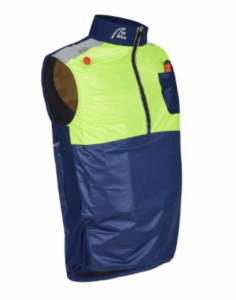
The New Wave Rowers Vest was, in fact, designed by a rower specifically for rowers. Similar to the Sea-Tee which is only available with manual inflation, the New Wave Vest offers the close fitting feel rowers prefer with automatic, hydrostatic inflation. Simply put, it inflates automatically when submerged in water (by the water pressure) but will not inflate when subjected to rain. (https://www.youtube.com/watch?v=k3f7OMK6Dbg) NOTE: unfortunately, this is not sold in the US at the time of this writing. We purchased one on-line through a European retailer.
Inflatable PFDs
Inflatable PFDs offer rowers protection without the bulk of traditional lifejackets. They’ve been around for almost thirty years now and are used for everything from commercial fishing and military applications to recreational boaters. USCG approved models all include a pull cord mechanism to inflate the PFD and many also include auto-inflation mechanisms that activate under hydrostatic pressure; i.e., they can’t be activated by rain, but require the pressure of actual submersion. They are not for children or non-swimmers, but there are several manufacturers and many different models available, including belt packs, suspenders, vests, and jackets.
Inflatable Belt Packs
Inflatable Belt Packs are designed to be worn around the waist and they inflate, if needed, with a pull-cord. Rowers who use them tend to wear them behind the back and forget they’re there. There are many USCG approved models on the market, two of which are shown below.
Inflatable Suspenders
Inflatable “Sospenders” were developed in the late 1980s and provide the protection of a lifejacket without the bulk, or possible chafing and overheating of traditional foam PFDs. They are available in manual (pull cord) or with auto-inflation mechanisms that activate under hydrostatic pressure (not rain). The two shown here are also USCG approved.
Inflatable Shirts & Vests
Soon after the development of inflatable PFDs manufacturers started adapting them into vests and jackets. Among these, the Stormy Seas V100 seems to be one of the more popular among rowers because of its comfort, loose fit, and lack of bulk and the Sea-Tee looks as if it was designed with rowers in mind, with inflatable floatation in a spandex tee-shirt. Both are manually operated and are categorized as buoyancy aids (i.e. they are not USCG lifejackets), but the Sea-Tee won the BoatUS Foundation and Underwriter’s Laboratory competition for innovated life jacket design, and both provide excellent floatation without bulk or chafing.
Foam PFDs
Foam PFDs are often disparaged by rowers who have never used them, but they offer the same warmth, wind protection, and comfort that rowers seek when they put on vests and fleece and jackets. Moreover, in the event of a cold-water accident they help keep you warm in the water as well as afloat.
European Racing PFDs
While the U.S. Coast Guard regulates PFDs in the United States, throughout most of the rest of the world they’re regulated by the CE standard of Europe. The principal difference, as I understand it, is that the US standard is designed to provide floatation for a 330 lb person, while the CE standard is based on a 220 lb person. As a result, racing PFDs outside the US are generally lighter, less bulky, and often more comfortable.
The Mocke Racer, pictured on the left, is one that I own and use frequently. It is ISO approved, NCRS approved for South Africa, and ICF approved. The new Gill Team Buoyancy, pictured on the right, appears to be slim and one of the less expensive on the market. (Both of these PFDs carry 50N flotation ratings, in comparison with the 70 N required by USCG PFDs).
USCG Approved Foam PFDs
Perhaps because I paddled whitewater canoes, C-1’s, and kayaks for many years before I began sculling, wearing a PFD was never an issue for me. Like helmets for biking and skiing, I don’t always wear them, but I wear them whenever there’s a reason. For rowing, the two USCG PFDs I’ve found most comfortable are pictured below.
[With my apologies to the manufacturers, these are photos of well-worn equipment]
For many of us who enjoy rowing, canoeing, or kayaking on cold water — and virtually all first responders familiar with water rescue — the resistance among most rowers to PFDs is hard to understand. Safety launches with experienced operators and appropriate equipment provide significant protection in the event of capsizing or being ejected, but PFDs provide additional protection that can make the difference between life and death in critical situations. Over the past couple of years clubs have begun recommending them for rowing on cold water or other potentially hazardous conditions.
PFDs provide no guarantee of safety and the examples shown above are not endorsements. But PFDs do provide significant protection and should be used whenever conditions warrant.
- To be precise, this language is from a club rule for cold water rowing that USRowing has referenced in its Safety Features several times, most recently in October 2014.
© 2022 RowSafeUSA.Org


